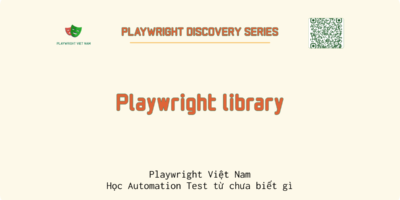1. Software Testing là gì? Mục đích chính của testing?
Câu trả lời: Testing là quá trình thực thi chương trình/hệ thống với mục đích tìm ra lỗi.
Mục đích chính:
- Phát hiện defects/bugs
- Đảm bảo software đáp ứng requirements
- Cải thiện chất lượng sản phẩm
- Giảm rủi ro và chi phí sửa lỗi
2. Phân biệt Verification và Validation?
Câu trả lời:
Verification: “Are we building the product right?”
- Kiểm tra sản phẩm có đúng theo specification không
- Thực hiện qua Review, Walkthrough, Inspection
- Không involve code execution
Validation: “Are we building the right product?”
- Kiểm tra sản phẩm có đáp ứng nhu cầu user không
- Thực hiện qua actual testing
- Involve code execution
3. STLC (Software Testing Life Cycle) gồm những phase nào?
Câu trả lời:
- Requirement Analysis – Phân tích yêu cầu, xác định testable requirements
- Test Planning – Lập kế hoạch test, estimate effort, resources
- Test Case Development – Viết test cases, prepare test data
- Test Environment Setup – Chuẩn bị môi trường test
- Test Execution – Thực hiện test, log defects
- Test Closure – Kết thúc, báo cáo, lessons learned
4. Phân biệt Test Plan và Test Strategy?
Câu trả lời:
Test Strategy:
- Document high-level, long-term
- Định hướng testing cho toàn organization/product line
- Ít thay đổi, độc lập với project
- Define testing approach, tools, best practices
Test Plan:
- Document chi tiết cho specific project
- Bao gồm scope, approach, resources, schedule
- Thay đổi theo từng project
- Based on Test Strategy
5. Black Box, White Box và Grey Box Testing là gì?
Câu trả lời:
Black Box Testing:
- Test mà không cần biết internal structure/code
- Chỉ quan tâm input/output
- Based on requirements/specifications
- Ví dụ: Functional testing, UAT
White Box Testing:
- Test với full knowledge về code/internal structure
- Kiểm tra logic paths, conditions, loops
- Cần programming knowledge
- Ví dụ: Unit testing, Code coverage
Grey Box Testing:
- Kết hợp cả Black Box và White Box
- Biết một phần internal structure
- Ví dụ: Integration testing, Database testing
6. Smoke Testing và Sanity Testing khác nhau thế nào?
Câu trả lời:
Smoke Testing:
- Test cơ bản để verify build có stable không
- Cover main/critical functionalities
- Wide and shallow approach
- Thực hiện mỗi khi có new build
- Automated thường xuyên
Sanity Testing:
- Test sau khi có minor changes/bug fixes
- Verify specific functionality works
- Narrow and deep approach
- Focus on changed areas
- Usually manual
7. Regression Testing là gì? Khi nào thực hiện?
Câu trả lời:
Định nghĩa: Test lại các chức năng cũ để đảm bảo changes/fixes mới không làm hỏng existing features.
Khi nào thực hiện:
- Sau khi fix bug
- Thêm feature mới
- Change requirements
- Update environment/configuration
- Performance improvements
- Patch updates
Best practice: Automate regression test suite
8. Bug/Defect Life Cycle gồm những status nào?
Câu trả lời:
- New – Bug mới được report
- Assigned – Assign cho developer
- Open/Active – Developer bắt đầu analyze/fix
- Fixed – Developer đã fix xong
- Ready for Retest – Deploy fix, sẵn sàng test
- Retest – Tester verify fix
- Verified – Fix confirmed working
- Closed – Bug closed successfully
- Reopen – Bug vẫn còn sau khi fix
- Rejected/Invalid – Không phải bug
- Deferred – Postpone sang version sau
- Duplicate – Bug đã được report trước đó
9. Severity và Priority của bug khác nhau như thế nào? Cho ví dụ
Câu trả lời:
Severity (Technical Impact):
- Mức độ ảnh hưởng đến system functionality
- Do tester định nghĩa
- Levels: Critical, Major, Minor, Trivial
Priority (Business Impact):
- Độ ưu tiên fix từ business perspective
- Do Product Owner/Manager quyết định
- Levels: P1 (Urgent), P2 (High), P3 (Medium), P4 (Low)
Ví dụ:
- High Severity, Low Priority: Application crash ở feature rất ít người dùng
- Low Severity, High Priority: Logo công ty hiển thị sai
- High Severity, High Priority: Payment gateway không hoạt động
- Low Severity, Low Priority: Typo trong help documentation
10. Entry Criteria và Exit Criteria trong Testing là gì?
Câu trả lời:
Entry Criteria – Điều kiện để bắt đầu testing:
- Test environment setup completed
- Test cases reviewed và approved
- Test data prepared
- Build successfully deployed
- Smoke test passed
- Required tools available
- Team resources allocated
Exit Criteria – Điều kiện để kết thúc testing:
- All planned test cases executed
- No Critical/Major bugs in Open status
- Test coverage đạt target (ví dụ: >80%)
- Performance benchmarks met
- UAT sign-off received
- Test report completed
- Defect metrics within acceptable range
BONUS: 5 Câu Hỏi Nâng Cao
11. Exploratory Testing là gì? Ưu nhược điểm?
Câu trả lời:
Testing approach không theo pre-defined test cases, tester tự do explore application dựa trên experience.
Ưu điểm:
- Tìm được unexpected/edge case bugs
- Creative và flexible approach
- Nhanh chóng adapt với changes
- Phù hợp cho Agile environment
Nhược điểm:
- Khó track test coverage
- Phụ thuộc nhiều vào tester skill
- Khó reproduce và document
- Không suitable cho regression
12. Test Coverage là gì? Các loại coverage?
Câu trả lời:
Metric đo lường bao nhiêu phần trăm application được test.
Các loại:
- Code Coverage: Statement, Branch, Function, Line coverage
- Requirements Coverage: Percentage requirements được test
- Test Case Coverage: Percentage test cases executed
- Feature Coverage: Percentage features tested
- Risk Coverage: Critical risks addressed
13. Boundary Value Analysis (BVA) là gì? Cho ví dụ
Câu trả lời:
Test technique focus vào test các giá trị tại boundary của input domain.
Ví dụ: Field chấp nhận tuổi từ 18-60
- Test values: 17, 18, 19, 59, 60, 61
- Minimum boundary: 17 (invalid), 18 (valid)
- Maximum boundary: 60 (valid), 61 (invalid)
14. Equivalence Partitioning là gì?
Câu trả lời:
Technique chia input data thành các equivalent classes, test một value từ mỗi class.
Ví dụ: Password field (6-12 characters)
- Class 1 (Invalid): < 6 characters (test với “abc”)
- Class 2 (Valid): 6-12 characters (test với “test123”)
- Class 3 (Invalid): > 12 characters (test với “verylongpassword”)
15. Adhoc Testing vs Monkey Testing?
Câu trả lời:
Adhoc Testing:
- Random nhưng có domain knowledge
- Tester hiểu application flow
- Có mục đích tìm specific defects
- Informal nhưng có logic
Monkey Testing:
- Completely random, no structure
- Không cần domain knowledge
- Random inputs/actions
- Mainly test stability/crash
Tips Trả Lời Interview
Khi được hỏi về Testing Basics:
- Structure câu trả lời: Definition → Explanation → Example
- Sử dụng real-world examples từ project/học tập
- Draw diagrams nếu cần (STLC cycle, Bug lifecycle)
- Show understanding về when/why/how
Template trả lời cho Intern:
"Theo em hiểu, [concept] là [simple definition].
Cụ thể hơn, [detailed explanation].
Ví dụ trong project em từng học/làm, [specific example].
Em nghĩ điều quan trọng nhất là [key takeaway]."
Khi không biết câu trả lời:
"Em chưa có hands-on experience với [topic],
nhưng based on em hiểu về testing principles,
em nghĩ [logical reasoning].
Em rất interested để học thêm về vấn đề này."



Trả lời